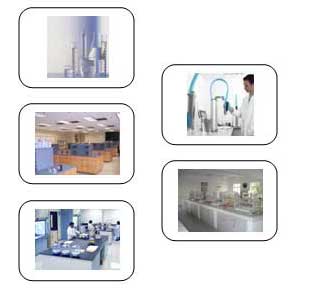In laboratories for many analytical & biological procedures, analysis and instruments pure water is needed. This pure water is identifies in terms of laboratory grade water which is measured in water Resistivity. Resistivity is determined by the amount of ionic contaminations and by its Total organic CARBON Content. Laboratory grade water quality is based American Society for Testing and Material (ASTM) definitions.

Applications Type II Distilled Water Unit
Type 2 RO water purification system is ideal for
• Buffer and standard pH reagent preparation
• Microbiological culture media preparation
• Cell culture incubators
• To feed clinical analyzers
• Analytical Instrument Tests
Salient features of chemtronics' type 2 lab water purification system
• Type 2 RO, easy to operate & maintain.
• Suitable for Tap water (corporation water) and post RO.
• Compact system including Reverse Osmosis technology with super charge deionization resin to produce high quality laboratory - grade pure water.
• Easy to install.
• Designed to fit your space requirements.
• Effective membrane filtration that removes all types of water contaminations.
• Membrane is maintaining due to the manual flushing cycles.
• Pre treatment to prevent the membrane from scaling formation.
• The built in UV lamp* is ideal for applications that require low bacteria levels.
• Online Conductivity meter to ensure the required water quality.
Feed water requirements of type II ultra pure laboratory water purification system
• Water Quality : Potable TAP Water
• Temperature : 35 °c - 40 °c
• Free chlorine : Less than 0.5 ppm
• Total dissolved solids : Less than 70 ppm
• Minimum feed pressure : 1.0 bar2.0
System specifications of type II RO pure water system
I) Pre-Treatment : To protect the system
Spun Cartridge Filter
The micron cartridge filter is provided for fine filtration of suspended solids. Filter is good for the removal of relatively uniform sized particles throughout the body of the filter.
When to Replace a Filter Cartridge
As particles accumulate on a filter cartridge, flow through the filter becomes restricted. This restriction reduces the flow rate through the cartridge and increases backpressure Thus the
Cartridge filter should be changed when the flow drop or pressure drop is considerable.
▪ Granular Activated Carbon
The granular activated carbon to eliminate free chlorine and colloids present in tap water that may otherwise alter the taste and color of your water supply.
Membrane Technology : To removes all dissolved inorganic & organic impurities
Reverse Osmosis System
a) RO Membrane
The membranes used have spiral configuration i.e. osmotic membranes are wrapped in a coil around central manifold.
b) Membrane Housing Vessel
The membrane is housed in ABS suitable for one element of standard size.
Permeate Rota meter
Allows the user to check the flow rate of RO permeate water.
Booster Pump
The pump is used where there is a mains pressure of 0.5 bars or less.
Ultra Filtration.
Ultra filtration is separation process using membrane with pore
size in the range between 0.1 to 0.012 micron. Typically ultra
filtration will remove high molecular substance colloidal
materials and organic and inorganic polymeric molecules.
U.V. System
UV system for very low bacteria levels. Type 2 RO water system can be equipped with a UV system .water is sanitized through a 254 nm UV lamp in a stainless steel housing. UV lamps kill any live bacteria & microorganisms.
Mix Bed Resin
The resin filters are a very high quality Semiconductor grade mixed bed resins that remove the last of the Ions from the RO water. The mixed bed resin removes the dissolved ions of various minerals from the water to bring the water resistively up to 0.1 This is what gives the final polish to the water.
III) Instrumentation : To control & monitor operation
Low pressure Switch
This is to avoid dry running pump. The changeover of LPS takes place depending on the line pressure at the suction of pump and pressure set point. In case of low pressure in pump suction, it trips off the plant.
High pressure Switch
This is to avoid pressure build up in the permeate line. The changeovers of HPS takes place depending on the line pressure at the discharge of permeate line and pressure set point (2 bar). In case of high pressure in the permeate line, it trips off the plant.
Operating instructions of type II RO lab water purification system
• Connect the Raw Water Pipe to the Water Connection.
• Put the REJECT pipe to the DRAIN line.
• Attach the PERMEATE line to the process water tank/lab machine where want to store or use water online.
• Start the Raw Water tap after starting the raw water tap then
Plug in the mains cord of the R.O Plant in a 5 Amp. Domestic Plug point power with proper earthing.
• ON 2 way switch & put on No.1 indicator. Indicates RED Signal.
• Then start RO Plant.
• Open flushing ball valve for membrane flushing. Do the
flashing with water for 5 to 10 min.
• After flushing close the flushing ball valve.
• Start type II distilled water RO.
Trouble Shooting For Type II RO Distilled Laboratory Water Purification System


Head Office: 28, Satyam Industrial Estate, Subhash Road, Jogeshwari (East), Mumbai, Maharashtra 400060